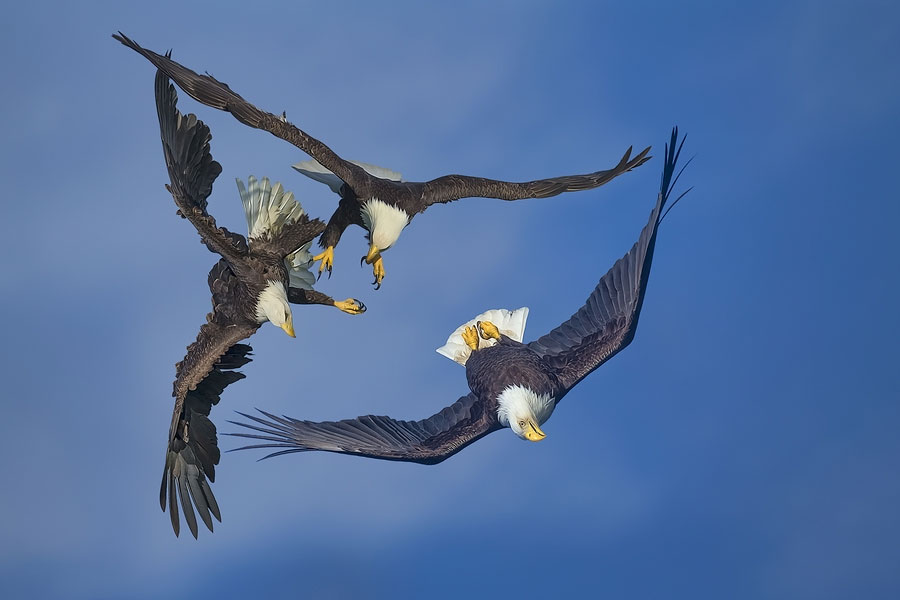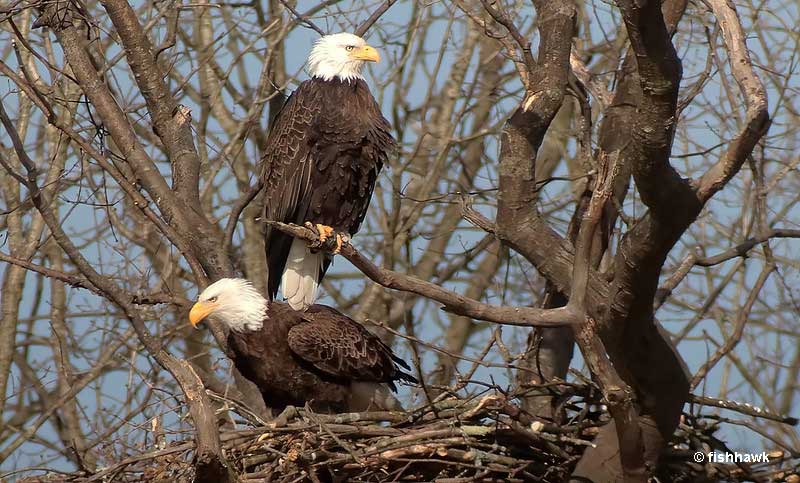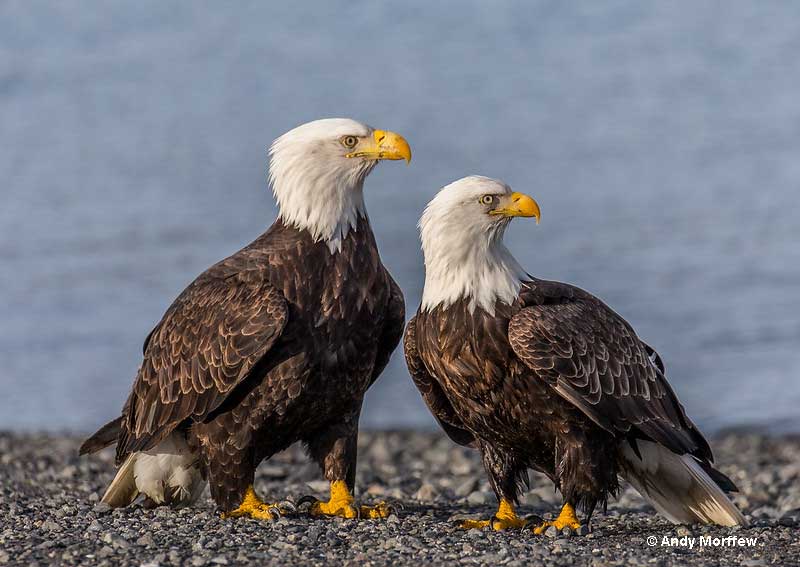
Eagles, arguably the most commonly known birds of prey, are characterized by their impressive aerial dives to capture prey. These majestic creatures possess exceptional eyesight and are able to achieve incredible flying and diving speeds. Although not inherently social, eagles come together in groups for specific reasons.
But what is a group of eagles called? The common names for a group of eagles are aerie, soar, and convocation. Continue reading to learn about the different collective nouns for these birds and more!
On this page
What Is A Group Of Eagles Called?
Groups of eagles have different names depending on where they are and what they’re doing. The primary term for a group of eagles is a convocation.
There are a wide variety of eagle species found worldwide, with some primarily being solitary in nature.

Bald Eagles are quite solitary creatures, often just interacting with their mates.
Several types of eagles occasionally display sociable behavior and form groups, even outside the breeding season. However, it’s not normal for these birds to reside in large social groups.
For the most part, they are solitary throughout much of the year. The exceptions occur during the breeding season and winter migration period for certain species.
For example, Bald Eagles may roost in the same area if it offers sufficient space or during unfavorable weather conditions. These communal roosts remain somewhat mysterious, although they have been observed in regions like Alaska. Encountering a substantial gathering of eagles is a rare occurrence, not commonly seen in their natural behavior.
In the United States, there are three different eagles – Bald Eagles, Golden Eagles, and occasionally Steller’s Sea-Eagles.
Why Is It Called A Convocation?
A group of eagles is usually called a convocation, but they can also be called an aerie or soar. The term convocation means a large gathering. In this case, it represents a large gathering of eagles.
Other collective nouns that are used for groups of eagles include aerie and soar.
The term aerie means the nest of a bird of prey. This term is used to describe a group of eagles that are nesting together. Bald Eagles exhibit monogamous partnerships from one breeding season to the next.
Related: Do eagles mate for life?
They come together, mate, and lay eggs, with both males and females taking turns protecting the eggs and hunting for food. Once the eaglets hatch, a small group or “aerie” is formed due to the close-knit family unit.

Judging by the size, female is on the left and male is on the right. Photograph © Andy Morffew
The term soar is yet another collective term to describe a group of eagles, connoting their skillful flight and ascent through the skies. Typically, eagles do not spend extended periods in the company of others outside of their immediate families. However, during the arrival of cold weather, they will sometimes migrate in groups.
Why Do Eagles Group Together?
There are several reasons why eagles form groups:
Winter Migration: Some eagle species participate in long-distance migrations during the winter months. During these migrations, they’ll gather in groups, following similar migration routes and benefiting from safety in numbers and shared knowledge of suitable feeding grounds.
Roosting: In colder regions with limited roosting sites, eagles may gather in communal roosts. These roosting sites provide warmth, protection, and safety during harsh weather conditions, enhancing their chances of survival.
An Abundance of Food: When there is an abundant food source in a particular area, many eagles might be drawn to the same location. This can lead to temporary gatherings, particularly if the food source is large enough to sustain several eagles.

Scavenging Opportunities: Eagles, especially younger or less experienced ones, may congregate around carrion or areas with plentiful food scraps, such as fishing harbors or dumping sites, to scavenge for food.
Protection Against Predators: In certain regions, eagles may gather in response to a common threat or predator, seeking safety in numbers to reduce the risk of individual attacks.
It is important to note that while these reasons may lead to temporary gatherings of eagles, their natural behavior remains largely solitary for most of the year.
Frequently Asked Questions
Do eagles have flocks?
Eagles do form groups, but throughout most of the year, they’re solitary birds.
What do they call a flock of eagles?
A group of eagles has a variety of different names, including aerie, soar, and convocation.
Is a group of eagles called aerie?
Yes, a group of eagles can be called an aerie. The term is used to describe a group of eagles nesting together. Once the baby eagles hatch, a small group or “aerie” can be seen in the nest. They’re a close-knit family unit.
Conclusion
Like many other birds, groups of eagles can have different names based on the behavior they’re exhibiting. For example, a group of eagles in flight is called a “soar,” and a large group of eagles, no matter what behavior they’re exhibiting, is called a “convocation.” Lastly, a group of eagles in a nest is called an aerie.
Most people call a group of eagles a flock; this is understandable because a group of birds is universally known as a flock.
However, as we discussed in this article, many different terms can be used to describe a group of eagles.
Each term carries its own meaning and is used in different contexts. Next time you see a group of eagles, take the time to admire these birds. They’re truly amazing, and now you’ll know what to call them based on the behavior they’re exhibiting!

